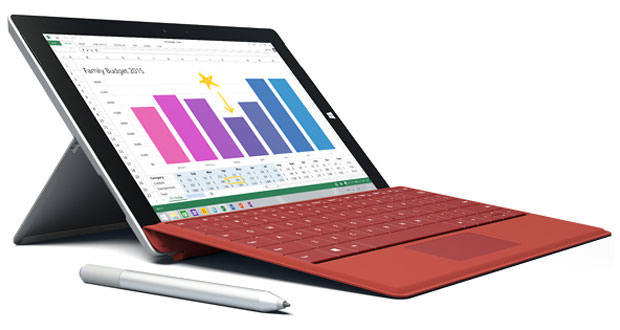This is the year of the computer fanless ultra thin, and prevail to this concept the new Surface 3, Microsoft introduced the new tablet a bit on the sly, but very interesting. Also coming in version 4G LTE.
Microsoft surprised everyone with the announcement of a new tablet that aims to take the place of a laptop at the same time while maintaining the portability of a traditional tablet. One could speak of a revised downwards by Surface Pro 3, for a pattern reminiscent of Surface 2 in design and size, but at the same time is able to run Windows 8.1 Traditional. Nothing RT, and no restrictions then.
We review the technical characteristics: within a chassis of 267 x 187 mm 8.7 mm often only find a display ClearType Full HD 10.8 ” with aspect-ratio of 3: 2 and a maximum resolution of 1,920 x 1,280. This is the same form factor of the Pro model, a compromise to get good results in both the viewing multimedia content, and for productivity on-the-go.
Microsoft has managed to maintain a passive design for heat dissipation, so no fans, as on Surface 2, which used a processor based on ARM architecture. This feature is made possible by the integrated processor, an Intel Atom Z8700-x7 quad-core can operate at the operating frequency of 1.6 GHz, which become 2 , thanks to 4 GHz Burst mode. Intel says one SDP (Scenario Design Power) of only 2W to the CPU, where it is also an integrated Intel HD Graphics GPU family.

According to data released by Microsoft, Surface 3 can operate up to a maximum of 10 hours of video playback when devoid of external power. There are two integrated cameras: the rear is equipped with auto-focus and can give shots to 8 megapixels, while the front uses a 3.5-megapixel sensor. Both are able to record video up to 1080p. Excellent options in terms of connectivity, especially considering the slim profile of the tablet.
Surface 3 has a USB 3.0 full-size, a Mini DisplayPort, a microSD card reader, the connector for the cover and a dedicated combo jack for headphones and external microphone. Microsoft abandons proprietary connector for charging the device, introducing a more traditional micro USB. Versions 4G LTE, which will arrive in an unspecified later, will also have a slot for nano-SIM.
The external power is 13 W, a power comparable to that of the products used on iOS or Android tablet with ARM processors. But Surface 3 is on paper much more: integrating an x86 64-bit and the same version of Windows that we find on our desktop, the new Microsoft tablet has the same functionality of a notebook, in a form factor thin and similar to that of a tablet itself. The weight is decidedly low, stopping just 622 g for the Wi-Fi version only.
We must make the necessary considerations on SoC chosen by Microsoft, a choice that seems bound by the limited heat capacity of a body – magnesium on Surface 3 – are so small. The Intel Atom Z8700-x7 is naturally not comparable to the Core i7 that we find on the Pro model and even the Core i3 entry-level variant is not to reject at the outset.
The lightness of Windows 8.1 could allow a good level of performance with the operations of every day, and to guarantee a good productivity suite with work more widespread.
The pre-order of Surface 3 is already active on the Store, and the first shipments will start on May 7. There are also new versions with 4G LTE network connectivity, but will be released to the public at a later time, with timelines not yet formalized by the company.


